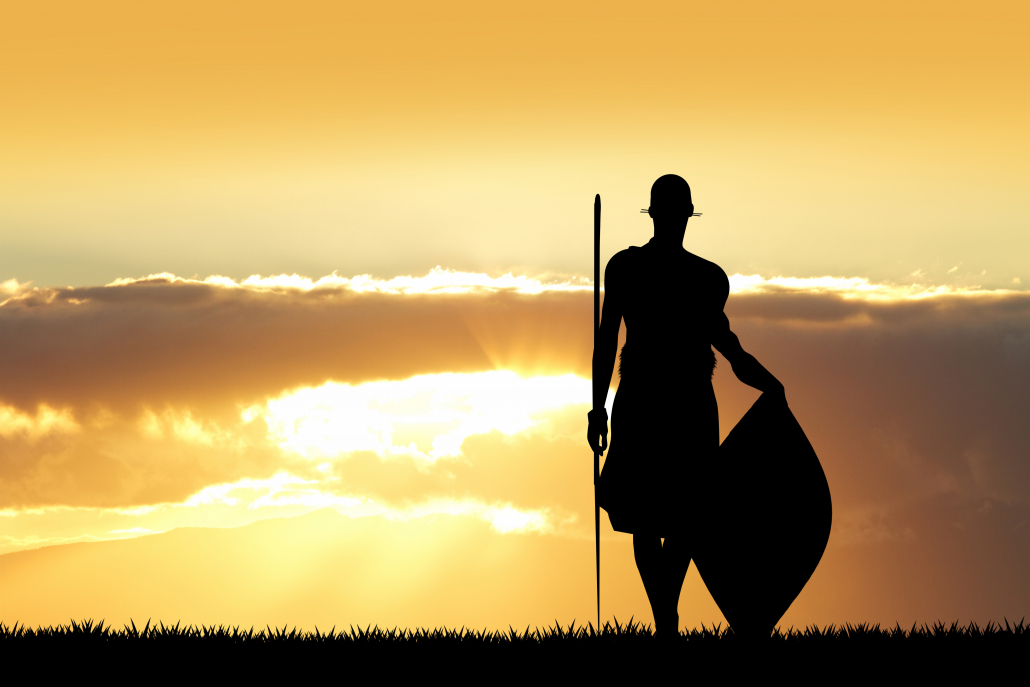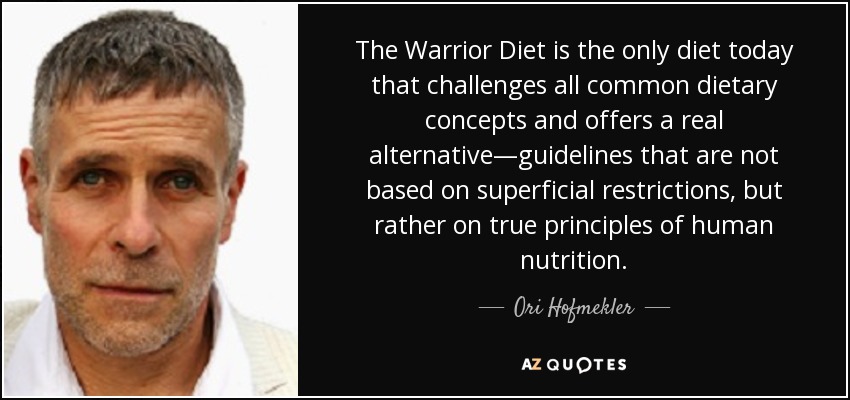We include products in articles we think are useful for our readers. If you buy products or services through links on our website, we may earn a small commission.
What is the Warrior Diet? Benefits, Drawbacks, and How To

Table of Contents
The Warrior Diet meal plan was created twenty years ago based on a much more ancient premise: humans were meant to move frequently and eat sporadically, given their reliance on hunting big animals. The creator of Warrior Diet, Ori Hofmekler, claims that following this eating pattern provides the simultaneous benefits of improved cognitive function and body composition.
So what exactly does the Warrior Diet entail? And is it effective?
In this article, we’ll explore the origins, benefits, and potential drawbacks or this popular approach to eating and wellbeing.
The History of the Warrior Diet
The Warrior Diet was created in 2001 by health enthusiast Ori Hofmekler.
A former member of “The Unit” (Israel’s most elite special forces team), Ori was looking for a way of eating that leveraged our history as hunter-gatherers to increase mental performance and burn fat. [1]
He designed the warrior diet as an attempt to mimic the way humans evolved to eat — little during the day, then a lot later on towards evening after a successful hunt. The diet calls for undereating for 20 hours per day then overeating for four.
The Warrior Diet is purported to “improve the way [you] eat, feel, perform and look” by triggering diet-related “survival instincts.”
Ori has admitted that his diet is based around personal experimentation and yet to be validated by science, though many adherents report the same benefits as Ori.

How to Do the Warrior Diet
The Warrior Diet can be viewed as a rather extreme form of intermittent fasting.
During the fasting period, dieters are encouraged to stick to liquids-only: coffee, tea, or other low-calorie fluids.
Eggs and certain raw fruits and low carb veggies are also permitted as needed.
Some Warrior Dieters go even further and just drink water — or abstain from liquids entirely — during the 20 hour fast.
Once the fasting period is over, it’s time to feast!
What to Eat on a Warrior Diet
Ori recommends that dieters stick with wholesome, unprocessed foods during the feasting period, though he’s not dogmatic about particular diets/protocols.
In keeping with the Warrior Diet’s ancestral eating inspiration, we recommend a nose-to-tail way of eating based around:
Organ meats are the most nutrient-dense foods on earth, but high-quality fresh organs can be hard to find, and frankly unpalatable for most people.
To conveniently boost your organ meat intake we recommend organ meat supplements, and beef liver supplements.
Is the Warrior Diet keto?
The traditional Warrior Diet called for cycling high-carb and low-carb days, Therefor the Warrior Diet can be considered a cyclical ketogenic diet.
Warrior Diet Meal Plan
Ori recommended hitting the following carb intakes each week on a warrior diet meal plan:
- 1-2 high carb days
- 1-2 high protein days
- 1-2 low carb days
- 1-2 low protein days
On high carb days, Ori recommended the following foods:
- Cooked vegetables
- Corn
- Potatoes
- Barley/oats
On high protein days, the preference shifted to the following types of foods:
- Hard-boiled eggs
- Animal protein
- Dairy products (we recommend full-fat A2 dairy)
- Non-starchy vegetables
- Tropical fruits
It’s been twenty years since the Warrior Diet’s inception. So the way people practice the warrior diet meal plan has evolved. Many people combine the Warrior Diet with a full-blown ketogenic diet, forgoing its high-carb days entirely. Others combine Warrior with a Carnivore diet meal plan.
Benefits of the Warrior Diet
Proponents of the Warrior Diet claim that this way of eating improves cognitive function, body composition, energy levels, and more. Let’s take a look at these claims to see whether or not they’re backed by science.
Benefit 1: Improved Cognitive Function
Many people notice that they become calmer and more clear-headed after just a few hours of fasting.
Intermittent fasting research backs up these reports. In fact, overconsumption of food has been shown to make us dumber. Evidently, our brains are hard-wired to function optimally during times of food scarcity. 1 This makes sense when you consider that when our ancestors were hungry they had to be really good at hunting.
Other studies on animals show that intermittent fasting reduces inflammatory markers, including TNF-a and IL-6. [2] Reducing these inflammatory molecules can set the stage for improved brain health and learning capabilities.
At the same time as these shifts, intermittent fasting is also boosting neurotropic molecules within the brain.
Foremost among these beneficial molecules is BDNF-1, or brain-derived neurotrophic factor. Harvard Neuropsychiatrist John J. Ratey calls BDNF-1 “Miracle-Gro for the brain.”
While adequate BDNF levels are correlated with faster learning, lower levels are correlated with neurodegenerative diseases including Parkinson’s and Alzheimer’s. [3] Animal studies show that intermittent fasting may protect against Alzheimer’s disease. [4]
Benefit 2: Improved Body Composition
Most — if not all — forms of intermittent fasting are thought to foster weight loss, but the Warrior Diet takes this trend a step further. Its 20-hour fasting window expedites calorie deficits that can lead to quick weight loss.
One study that looking at a 20-hour fasting protocol found that people who consumed their calories within a 4 hours window lost more weight than those who followed an isocaloric diet with meals throughout the day. The fasting participants also gained muscle, even as they lost fat mass. [5]
A multi-study review confirms that IF may promote weight loss even in the absence of any dietary changes. [6]
It appears that the Warrior Diet may teach your body to use calories more efficiently. During the feasting period calories are partitioned towards muscle mass; during the feasting period, stored calories are used for fuel.
Benefit 3: Improved Energy Levels
Fasting isn’t just known for improving cognitive energy — it’s known to boost physical energy levels, too. Some people find that they’re unusually productive during the Warrior Diet’s 20-hour fasting period.
This productivity boost likely occurs thanks to blood sugar stabilization. Going long periods without food can help your body keep its blood sugar in a healthier range, which in turn leads to much more stable energy levels.
Studies show that IF’s ability to stabilize blood sugar leads to decreased bodyweight and higher energy levels. [7] 8
Hormonal shifts play a role in the energy-fasting link, too. Hormones like epinephrine norepinephrine are released from the adrenal glands during the fasting period, allowing your body to reach a more energized state.
Benefit 3: Reduced inflammation
Chronic inflammation is one of the most universal causes of disease. Inflammation is correlated with increased risks of diabetes, cardiovascular disease, and even cancer. [8]
Given that fasting reduces inflammation, perhaps it’s not surprising that simply not eating was once viewed as one of the most universal healers.
Modern research seems to confirm this timeless truth. One study of over 30 men found that 16/8 intermittent fasting decreased inflammatory markers. [9] Another study of over 50 people found that fasting for Ramadan lowered these very same markers. [10] It’s likely that the Warrior Diet’s 20/4 fasting pattern leads to similar benefits.
Drawbacks of the Warrior Diet
As effective as the Warrior Diet may be at improving cognition and body composition while boosting energy, it does have some potential drawbacks.
Drawback 1: It Can Be Difficult to Stick to
Going a full 20 hours without food each and every day runs counter to many modern ideas about healthy eating.
Participating in normal social activities can become tough when you don’t partake in communal eating. While some people are able to say no to morning pastries and afternoon snacks, many people find the Warrior Diet too mentally taxing.
If you find it too difficult to stick with, don’t sweat it — you can always try 16/8 or even 12/12 IF instead, other gentler intermittent fasting methods.
Drawback 2: May be Inappropriate for Some Groups
The Warrior Diet isn’t for everyone. In fact, there are some groups that it’s almost definitely not meant for:
- Children
- Type 1 diabetics
- Endurance/elite athletes
- Underweight individuals
- Nursing/pregnant women
- Those with eating disorders
- Those with high-calorie requirements
If you’re a slow eater with high-calorie requirements, then this diet will look very similar to the OMAD diet, and that may not be ideal.
While nursing and/or pregnant women should definitely stay away from the Warrior Diet, this way of eating might not be ideal for women in general. Some research implies that fasting affects a women’s hormonal balance more harshly than it affects a man’s. [11]
You can learn more about the best intermittent fasting strategies for women here.
Drawback 3: May Have Unwanted Side Effects
Potential side effects on the Warrior Diet include [12]:
- Fatigue
- Fainting
- Dizziness
- Moodiness
- Low energy
- Low blood sugar (hypoglycemia)
The above side effects are similar to those that occur when transitioning to keto, not affectionately known as keto flu.
It’s likely that these side effects are attributable to the transition from burning carbs for fuel, to breaking down fatty acids for fuel in a metabolic process called ketosis.
What this tells us is that avoiding Warrior Diet’s side effects may be as simple as speeding up keto adaption with gentle exercise, coffee, MCT oil, and keto bone broth.
Warrior Diet: The Takeaway
The intermittent fasting Warrior Diet is a special type of IF that cycles between 20 hour periods of undereating and four-hour periods of overeating.
While the Warrior Diet likely results in many of the same health benefits as other types of fasting, research has yet to conclusively proven that this diet is as effective as its proponents claim. Some people find the Warrior Diet too restrictive and too difficult to follow.
A Warrior Diet meal plan focuses on whole animal foods with plenty of healthy fats to feed your body when it’s in ketosis.
If you’re not among the groups that should avoid the Warrior Diet, however, then feel free to try it out for yourself! It might provide the cognitive boost, body composition, and energy consistency you’ve been looking for.




















